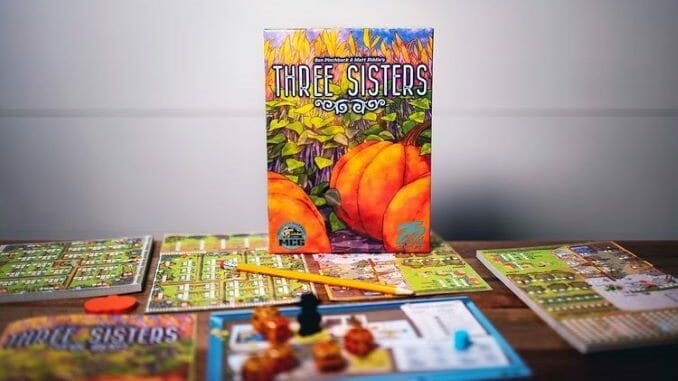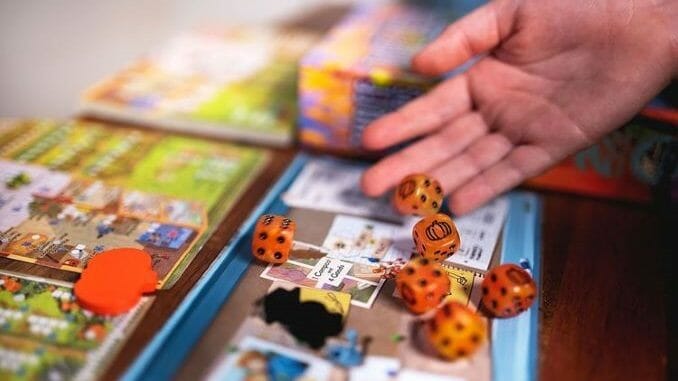Three Sisters is a new roll-and-write from the designers of Fleet: The Dice Game, and it is utterly fantastic. Based on the companion planting technique that indigenous peoples in the Americas have used for several thousand years, the game has a brilliantly complex system of interconnected rewards and bonuses that makes for an intellectual puzzle I wanted to play again and again.
The “three sisters” technique involves growing corn, beans, and squash together for their symbiotic relationship in the field. Corn stalks give beans natural trellises to climb, beans fix nitrogen in the soil, and squash provides natural ground cover to reduce evaporation and prevent weed growth, while all three crops, consumed together, provide all nine essential amino acids that humans can’t produce for themselves. Matt Riddle and Ben Pinchback, the designers of Three Sisters, also worked with two indigenous advisers who read the game’s rules and reviewed its art to ensure they used the theme and topic with respect, without cultural appropriation.
In Three Sisters, players have two scoresheets that they’ll mark up over the course of the game, one of which shows the player’s garden, with six zones, and six different perennial flowers beneath them, while the other shows the player’s shed, apiary, fruit trees, compost bin, and the generic “goods” section that matters a lot more than the name implies. The start player for each round rolls the dice, two more than the player count, grouping them by value (one through six, with the one’s single pip replaced by the image of a pumpkin) and places them on the rondel on the small, central board. Players then go in turn, selecting one die and taking two actions based on the die’s value and the space on which it was resting, after which all players use the lowest remaining die for two more actions, again based on the die’s value and location.
The first action, based on the value of the die, is a Plant or Water action: You may start two new plants in the zone in your garden matching that die’s value, or you may water all plants in that zone. Each zone has some number of corn, bean, and squash plants within it. Corn plants are four spaces tall, while their adjacent bean plants are two spaces tall. When you complete a corn plant, checking off all four spaces, you get three victory points; once you’ve completed the second box of a corn plant, you can start the bean plant, which is worth one point when finished. The squash plants vary in size, but when completed, you get one to three goods (not points), and if you finish two adjacent pumpkins, you also check off the perennial flower space between them and fill in a space in that flower’s column at the bottom.
Then you do the second action, based on the space underneath the die. These can involve a free Plant/Water action, checking off a space in your Shed, checking off a space in your Apiary or on a Fruit tree, gaining a compost and four goods, or visiting the Farmer’s Market. The Shed has a dozen items you can complete that give you ongoing benefits, or regular bonuses, or game-end points bonuses. The Apiary and Fruit, like the Perennials, can do the same, with increasing benefits as you go. The Farmer’s Market gives you benefits based on how many goods you’ve gathered, marking off more perennial and maybe fruit spaces.

There are also bonus actions available based on your goods—every time you gather another five goods, you get a free bonus action, checking off one space in any area other than your garden. Your compost is useful when the dice hate you, with one compost used to add or subtract one from the die’s face value (one and six are considered consecutive). Compost is kind of underpowered, although you can get an item in the shed that lets you use three compost for a free bonus action, which is pretty great. Without that, you’ll probably end the game with a bunch of unused compost, which is the opposite of my experience as a home gardener, at least.
At the end of each round, everyone takes a collective action, marking a space in the shed, visiting the farmer’s market, or watering all six zones of their gardens when it rains. After eight rounds, you tally up all of your points and declare a winner.
I do greatly enjoy a good roll-and-write game. The Clever series (That’s Pretty Clever!, Twice as Clever, Clever Cubed, Why I Am So Clever) is the exemplar here, incredibly replayable and very rewarding thanks to the cascading bonuses you can create through a little strategy. Seven Bridges is also very … um, clever, and greatly rewards strategy even with the randomness inherent in a dice game. Dinosaur World: Rawr and Write! was one of my top games of 2021, and it’s the one that came to mind with Three Sisters, in no small part because of its scope.
Roll-and-write games are growing up, getting more ambitious and asking players to do more—to cover more ground (literally, in this game), and to think more to build those bonus chains that I find to be the best part of a roll-and-write. Three Sisters does that, in spades (get it? Spades? Never mind). You can acquire tools early in the game that will expand the power of the Plant action or the Rain phase, or that give you extra goods when you harvest certain fruit. You can go around the edges of your garden, trying to finish all the squash so you get all the perennial bonus actions, which in turn trigger more bonuses as you work your way up each perennial column. Plus the squash gives you lots of goods, and if you rack those up, you get bonus actions from the goods section. You can often use a bonus action to do something else that gets you more goods and triggers another bonus action. There’s a lot of this in Three Sisters, starting in round two or three at the latest. If you like that stuff, this game is very much for you.
The art itself, by the acclaimed illustrator Beth Sobel, is appealing, but the combination of small black text on detailed, richly colored artwork makes it really difficult to read unless you’ve got great lighting—and even then I had to get my reading glasses. The game comes with a solo mode, where Edith, who is apparently a very evil rival farmer, crosses out things all over your scoresheets in each round, which I found a very frustrating experience compared to the competitive game. This is also a small quibble, but we all thought it was strange that the final action of the game is another rainfall rather than a visit to the Farmer’s Market—mechanically, it makes sense, but thematically it seems backwards. You end the year by selling your wares, right? Harvest in September and go to market. Instead, it rains.
My wife and I were up till 1 a.m. the night before I wrote this review, playing this game just one more time, and in our final play we tied with 115 points despite wildly divergent strategies: she went heavy on the apiary, I went heavy in the garden and timed everything well enough so that the final rain phase gave me 19 additional points. I know people have reported higher scores online, so we haven’t completely cracked the code, but even crossing triple digits felt like an achievement. Packing all of this into a game that takes about 45 minutes is impressive. Clearly, I am very remiss in never playing Fleet: The Dice Game, because these two designers have created a winner here.
Keith Law is the author of The Inside Game and Smart Baseball and a senior baseball writer for The Athletic. You can find his personal blog the dish, covering games, literature, and more, at meadowparty.com/blog.

